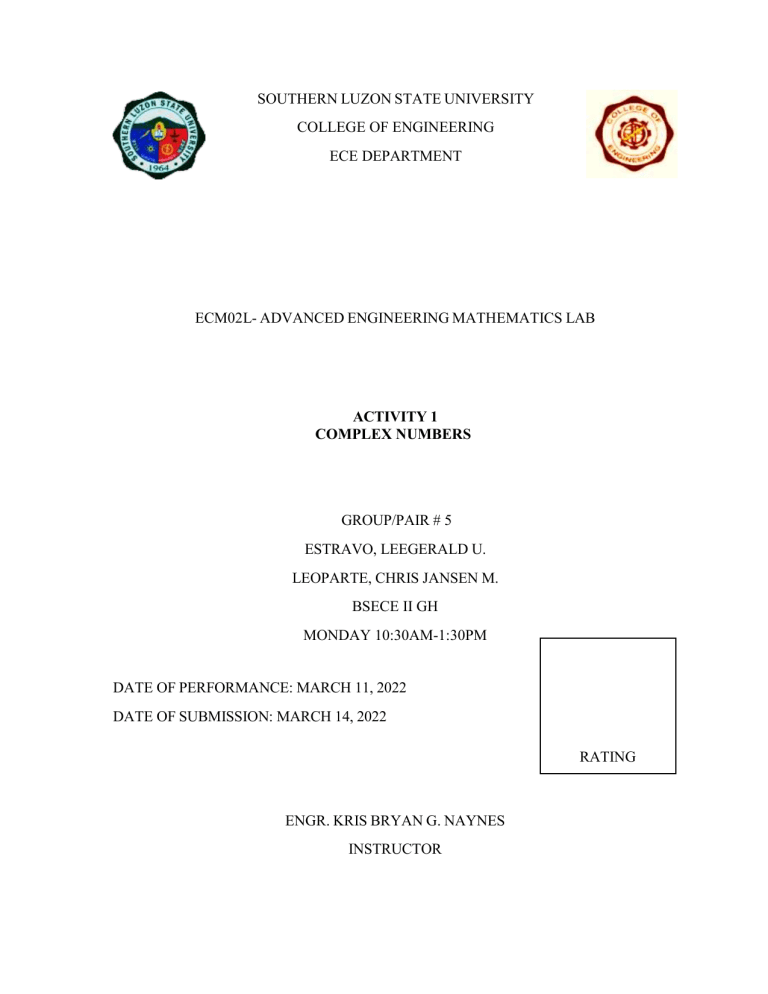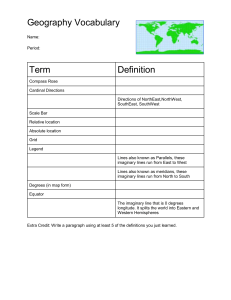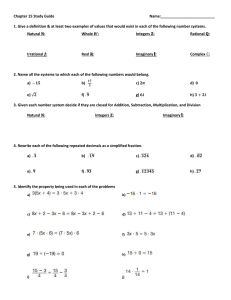
SOUTHERN LUZON STATE UNIVERSITY COLLEGE OF ENGINEERING ECE DEPARTMENT ECM02L- ADVANCED ENGINEERING MATHEMATICS LAB ACTIVITY 1 COMPLEX NUMBERS GROUP/PAIR # 5 ESTRAVO, LEEGERALD U. LEOPARTE, CHRIS JANSEN M. BSECE II GH MONDAY 10:30AM-1:30PM DATE OF PERFORMANCE: MARCH 11, 2022 DATE OF SUBMISSION: MARCH 14, 2022 RATING ENGR. KRIS BRYAN G. NAYNES INSTRUCTOR I. OBJECTIVES 1. To be able to be familiarized of using MATLAB. 2. To be able to differentiate between real and imaginary parts of a complex number. 3. To be able to demonstrate the different mathematical operations of complex numbers. II. INTRODUCTORY INFORMATION Complex numbers consist of two separate parts: a real part and an imaginary part. The basic imaginary unit is equal to the square root of -1. This is represented in MATLAB® by either of two letters: i or j. Complex numbers are written in the form x + yi and consist of two parts: the real part and the imaginary part. The real part is the real x and the imaginary part is yi. The complex number z consists of an ordered pair of real numbers x and y described as z = (x, y). Where x is called the real part and y is called the imaginary part. Addition, subtraction, multiplication, and division can be used to solve complex numbers. In MATLAB®, i and j represent the basic imaginary unit. You can use them to create complex numbers such as 2i+5. You can also determine the real and imaginary parts of complex numbers and compute other common values such as phase and angle. III. PROCEDURES In number 1 what we did was we first identify the right procedure for each problem. In finding the results in each formula we encounter some problems along the way but with the help of the guide videos that are given to us we are able to solve and simulate the given problems. It made easier for us to find the program to perform the following operations that is given in the table. In number 2, there are many conflicts due to the value specified in the data. But after all, there is an easier way to find individual values, whether they are related or not. When solving the left and right sides, both sides have different values, so you need to check if they are related to each other. In Exercise 3, you need to solve all the given complex numbers. MATLAB made it easy to enter the correct syntax in the software and returned the correct value. After the values were retrieved, they were tabulated in table c. 2|P age IV. DATA AND RESULTS 1. Given the following two complex numbers: 𝑧1 = 1 + 2𝑖 and 𝑧2 = 3 + 4𝑖 Variables: Write a MATLAB program that performs the following operations: Output a. 𝑧1+𝑧2 b. 𝑧1−𝑧2 c. 𝑧1⋅𝑧2 (the ⋅ denotes product) d. 𝑧1/𝑧2 e. 𝑧1∗ 𝑎𝑛𝑑 𝑧2∗ (recall that the * denotes complex conjugate) & f. real(𝑧1 ⋅ 𝑧2) and imag(𝑧1 ⋅ 𝑧2) & g. real(𝑧1 + z2) and imag(𝑧1 + 𝑧2) & h. v = real (𝑧1) + imag(𝑧1* 𝑧2) i. w = imag (𝑧2) + i real(𝑧1 + 𝑧2) j. (𝑧1 ⋅ 𝑧2)* and (𝑧1+ 𝑧2)* & k. mag. of |𝑧1| and |𝑧2| & l. Phase angles of 𝑧1 and z2 & 3|P age 2. Using MATLAB, verify which of the following relations are true. (Solve both side of the equation and write in rectangular form) LHS RHS EQUAL/NOT EQUAL (3 − 2𝑖)2 = −9 − 46𝑖 Not equal √3 − 2𝑖 = √7(cos 310° 89′ + 𝑗 sin 310° 89′ ) Not equal 1 + √3𝑖 = (1 + √3) cos 90° Not equal 1 − √3𝑖 = 2(cos 300° + 𝑗 sin 300°) Not equal −√3𝑖 = √3(cos 180° + 𝑗 sin 180°) Not equal (3 + 𝑖)(1 − 𝑖)2 13 9 = + 𝑖 (𝑖 − 3)(3 − 𝑖) 25 25 Equal 5(−3𝑖)(1 + 𝑖) 5 − √5 ∙ 𝑖 = −3.62 − 1.38𝑖 (1 + 5𝑖)−3 = −0.004 + 0.06𝑖 3. Given the complex numbers 𝑧1 = 3 + 4𝑗 and 𝑧2 = 5 + 𝑗2. Use MATLAB and evaluate the following: Variables: 4|P age Equal Equal a. |𝑧1|, |𝑧2|, and |z|, where z = z1/z2 b. ∠𝑧1, ∠𝑧2, and ∠z c. |𝑧1| ⋅ |𝑧2| d. |𝑧1| ⋅ |𝑧2*| or e. |𝑧1| ⋅ |𝑧2*| or f. |𝑧1* ⋅ 𝑧2*| or g. 𝑧1 ⋅ 𝑧2 (* denotes complex conjugate) V. CONCLUSION Through performing the experiment, we can conclude that understanding the process of solving complex numbers is important for evaluating various complex equations. MATLAB helped us to perform basic complex operations in using the software. You can use i to enter complex numbers. You also can use the character j as the imaginary unit. To create a complex number without using i and j, use the complex function. z = a + b i returns a complex numerical constant, z When calculating a rectangular equation, you need to get the values of x and y and follow a specific equation. There were some mistakes in running the experiment maybe due to error in the syntax, but you can revisit and use the software to see and double check the answers. VI. REFERENCES none VII. CONTRIBUTIONS Leegerald Estravo answered exercise 2 and 3 and did the procedures for 2 and 3 and also did the references, objectives and edited the lab report. Chris Jansen Leoparte did the introductory information and answered exercise 1 and procedures for number 1 and made the conclusion. They brainstormed and helped each other in gathering the Data and results and doing the lab report for this experiment in order to do the task. 5|P age 6|P age






